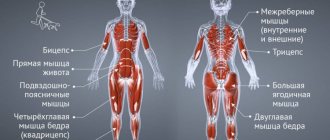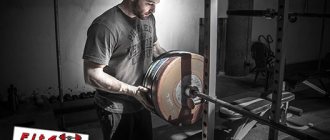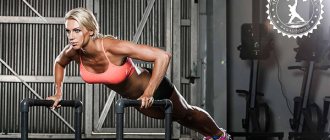Sorokopud Alena, 33 years old.
(c) Before pregnancy, I did CrossFit for 3 years and now I didn’t want to stop at all :).
I started working out after the third month. I purposefully wanted to train with Inna, because she already has experience training pregnant girls and everyone felt great :).
Of course, training before pregnancy and now are radically different. Now I constantly monitor my breathing and pulse. I shouldn’t have shortness of breath so that the baby doesn’t lack oxygen. All abdominal exercises and jumping exercises were excluded. Although now my workout is more like exercise, it greatly affects my well-being.
I noticed that without training I feel drowsy, I feel heavier and irritable, but as soon as I train, everything goes away. Training is always fun and enjoyable. Now I’m 7.5 months old :), I’m going to go to training until the 8th month, and after that I’ll prepare for other training
I am very grateful that there are such wonderful trainers as Inna, who will always support you in word and deed :), will not let you get discouraged and will help you stay in shape, even during pregnancy.
I lead an active lifestyle - horse riding, a little gym.
And I noticed that CrossFit really become fashionable, but I haven’t had a chance to try this sport myself yet. But during pregnancy , every woman herself understand and feel what she can do and what she cannot. If you have strength and desire , then everything is fine .
I lead an active lifestyle as
much as time allows. I mainly do running - 2 times a week or light exercises at home (squats, lunges, abs, planks). I haven't heard of CrossFit. As for complex strength training during pregnancy , attitude towards such loads . This is dangerous for the child in my opinion. Personally, I wouldn't do CrossFit while pregnant.
Can heavy weight training cause complications during pregnancy for expectant mothers?
As the doctor Olga KHANOVA says in an article on motherhood for the resource mama66
, lifting weights is dangerous for your health for three reasons:
- Displacement of vertebral discs
. Due to the fact that during pregnancy the fetus takes a lot of calcium from the mother for its development, women's bones become more fragile. Lifting weights puts enormous stress on the spine, thereby promoting displacement of the spinal discs, which increases the risk of hernias. - Varicose veins and other vascular disorders
. Changes in the body of a pregnant woman lead to a decrease in the tone of the veins. Systematic lifting of weights leads to impaired blood flow, which increases the risk of developing varicose veins and deteriorates the supply of oxygen and nutrients to the brain, heart, and uterus. - Premature birth or miscarriage
. Lifting weights is accompanied by tension in the abdominal muscles and an increase in intra-abdominal pressure. This leads to contraction of the uterus and expulsion of the fetus.
But the doctor notes that these dangers can be avoided by those mothers who are already accustomed to moderate weight lifting and strength training. However, we should not forget that each organism is designed uniquely, and there are many factors that lead to pregnancy complications. Of course, it’s not worth giving up sports as such. Moderate, regular sports activities can provide benefits, which will help provide the fetus with the necessary amount of nutrients and sufficient oxygen for favorable development. Still, you need to remember the risks of excessive sports activity.
https://youtu.be/cUmkxiFoRq8
During pregnancy, which proceeds without pathologies, it is useful to engage in physical activity, but, of course, there is no need to set sports records. The intensity of training should depend on training, concomitant diseases and characteristics. In this matter, you should listen to the opinion of experts and your own intuition, and also, if you already have sports experience, smoothly regulate physical activity, focusing on internal sensations.
If the expectant mother is healthy and has no contraindications, fitness classes will help maintain good physical shape and psychological well-being. Exercise improves posture, helps prevent excess weight, back pain and relieves fatigue. Regular physical activity also reduces the risk of cardiovascular disease, gestational diabetes (a common metabolic disorder in expectant mothers), relieves stress and develops endurance, which is so necessary before and after childbirth.
The American College of Obstetricians and Gynecologists (ACOG) also encourages women to be active, regardless of their status or not:
«Physical activity at all stages of a person’s life maintains and improves the condition of the cardiorespiratory system, reduces the risk of obesity and subsequent diseases, and leads to an increase in life expectancy. During pregnancy, the risks of exercise are minimal and have been shown to benefit most women, but some exercise should be avoided due to normal anatomical and physiological changes and the needs of the fetus. Women with uncomplicated pregnancies are advised to engage in aerobic and strength exercises before, during and after pregnancy
“,” according to a 2020 ACOG article.
As soon as you find out you are pregnant, be sure to consult your doctor before starting or continuing exercise. You need to be especially careful from weeks 1 to 3, since this is the first critical period. At this time, the fetus is most vulnerable, and unusual excessive activity can create a threat of miscarriage.
Physical activity allowed during pregnancy:
- hiking
- swimming
- aqua aerobics
- low intensity aerobic exercise
- yoga (adaptive)
- Pilates (adaptive)
- not heavy strength training for those who did it before pregnancy
First trimester (1-12 weeks)
This period is considered the most responsible. At this time, the laying and formation of the baby’s organs and placenta occurs. The embryo develops rapidly and this largely depends on the state of the mother’s body. Typically, doctors are against any exercise for up to 12 weeks, considering the 13-15th week of pregnancy to be a more favorable time to start exercising.
In addition, in most cases, the onset of pregnancy is accompanied by malaise (toxicosis): weakness, drowsiness, irritability, nausea, and heartburn. It is extremely difficult to train during this period, and sometimes just to get out of bed, so it is better to refrain from any exercise, with the exception of walking in the fresh air, yoga for pregnant women, and mastering proper breathing techniques. The main thing is not to exhaust yourself - the goal should be a light to moderate exercise program.
Second and third trimesters (13-40 weeks)
This is the safest period for fitness: the expectant mother’s condition stabilizes, toxicosis passes, and the placenta begins to function fully. But it is important to remember that during this period, joints, ligaments and connective tissue soften under the influence of the hormone relaxin, so you need to be careful when lifting heavy weights.
Exercises in the 2nd and 3rd trimesters are largely aimed at strengthening the pelvic floor muscles (Kegel exercises), back muscles, legs, shoulder girdle, and proper breathing techniques. Important feature: movements are performed only while lying on your side or sitting (lying on your back after 16 weeks is not recommended). The fact is that the growing uterus in the supine position begins to compress the main vessels that are located in the pelvic area. In this case, the blood flow to the heart may be disrupted, which will lead to unpleasant symptoms and may affect the well-being of not only the mother, but also the baby.
After consulting with a doctor, it is permissible to introduce simple exercises, starting from 15 minutes several times a week. However, a number of directions and movements should be avoided:
- jumping, running, shock loads
- aerobic machines (stepper, elliptical, rowing)
- abdominal exercises
- high intensity loads
- balance and agility exercises
- training with heavy weights
- sudden movements and turns of the body
- complex static work
Principles of training for pregnant women:
- The intensity of the load is determined individually
- Each lesson begins with a warm-up and ends with a cool-down (light stretching, slow walking)
- Monitor your pulse and breathing, sweating, skin color
- If you feel dizzy when lying on your back, your breathing becomes faster, you need to turn on your side or sit down
- If unpleasant symptoms appear, training should be stopped.
- Physical activity should begin with light exercises, gradually increasing the load
- After performing floor exercises, stand up slowly and gradually to prevent dizziness.
- The optimal time for exercise is 1.5-2 hours after eating
- Don't exercise on an empty stomach
- Breathing exercises should be performed no more than 10 minutes a day
- Don't exercise to the point of exhaustion. During the training process, a woman should speak normally and not choke
- It is better not to exercise in extreme heat and high humidity.
The environment should be comfortable, you should wear loose clothing and special supportive underwear, and drink enough water. To facilitate the work of the back and abdominal muscles, you can wear a bandage. It is advisable to practice under supervision or with the help of a trainer.
Thus, fitness is an important means of preventing complications of pregnancy and childbirth. Systematic moderate-intensity training reduces the risk of serious complications, and in some cases almost completely eliminates them.
There are certain movements and sports that you should avoid during pregnancy, especially in the 2nd and 3rd trimesters. These include wrestling, boxing, water skiing, snow skiing, horseback riding, volleyball, baseball, soccer, softball, roller skating, rock climbing, and ice skating/hockey.
You should also not engage in sports that:
- includes intense exercise and increases body temperature
- may cause a fall or collision
- involves jumping or bouncing
- requires a sudden change in direction of movement
- involves diving to depths (diving) or climbing to heights (mountain climbing)
Before you start exercising, consult with your obstetrician/gynecologist who is caring for your pregnancy and your trainer to determine a fitness routine that is safe for you.
There is an established stereotype about pregnancy in society. As a rule, at this time expectant mothers have to give up many things to which she is accustomed. The reason is fear of harming the baby. But the hardest thing is for athletes who have dedicated their whole lives to sports.
We asked exciting questions about training during pregnancy to our expert panel, which included sports mothers who are used to always being in great shape. They are always determined to achieve results, to win medals and cups, but they do not consider them their main achievement in life. What kind of athlete mothers are they, how do they raise their children, and does motherhood interfere with high achievement sports?
- Anastasia Ganina is a master of sports in canoeing, silver medalist of the World Championship, CrossFit athlete, participant of the 2019 CrossFit Games and a happy mother of three daughters.
CrossFit during pregnancy – is it compatible? Sooner or later, female athletes face an important dilemma - how to combine the expectation of a miracle and the joy of motherhood with their favorite sport? Should you completely give up training for these 9 months or can you continue to do some types of exercise while maintaining your physical fitness? We will try to consider the answers to these, as well as other important questions, in this article, weighing the pros and cons.
Coach's comment
In order not to harm their body, expectant mothers need to strictly monitor the exercise process. We asked Ksenia Shulga, senior trainer of the X-Fit Mosfilmovsky club, master trainer of the group programs of the federal network of fitness clubs X-Fit, about the rules of training during pregnancy.
1. Please tell me, where is it better for expectant mothers to go: classes in groups or individual classes?
Both types of occupations are suitable for expectant mothers, but we must remember that the specifics of work in each of them are different
In group classes, the trainer cannot pay attention to each client. This means that the risk of injury increases significantly
Moreover, classes are held with the same intensity for everyone, which can negatively affect the condition of the expectant mother, since different levels of load are permissible at different stages of pregnancy. During individual lessons, the instructor constantly monitors the entire training process. The instructor monitors the gestational age and, based on this, adjusts the training program. Of course, the cost of individual lessons is higher than group lessons. However, the effectiveness of individual training justifies all the costs.
2. Is it safe for expectant mothers to perform exercises at home?
At any stage of pregnancy, it is recommended to do exercises every morning. Regular gymnastics will help reduce swelling and maintain the overall tone of the body. But you shouldn’t do fitness at home on your own. When training at home, expectant mothers, as a rule, rely on articles and video lessons from the Internet that do not take into account the health characteristics of a pregnant woman. This approach can harm the body of the expectant mother and the development of the child. Do not forget that during pregnancy, professional supervision by a specialist and a competent selection of exercises, adapted for each trimester of pregnancy, are more important than ever. That is why it is preferable to work out in a fitness club.
3. Are breathing exercises beneficial for expectant mothers? Which ones would you recommend?
Breathing exercises are very important and necessary during pregnancy. Breathing with delay, full yogic, chest, abdominal, intermittent and superficial breathing - these are the main types of breathing that will help the expectant mother maintain her body in good condition throughout pregnancy. These exercises will also make the birth process easier.
4. What types of activities are most suitable for expectant mothers?
The following activities are most suitable for expectant mothers:
• walking;
• swimming;
• yoga and Pilates, specially adapted for pregnant women.
5
What precautions should pregnant women take while exercising?
For expectant mothers, it is important not to overheat, exercise regularly, avoid pain, control your heartbeat, and drink more fluids. 6. Which parts of the body are strictly forbidden to put stress on during pregnancy? What parts of the body, on the contrary, should be worked out?
6. Which parts of the body are strictly forbidden to put stress on during pregnancy? What parts of the body, on the contrary, should be worked out?
You can't train your abdominal muscles. You need to train your back muscles, pectoral muscles and arm muscles.
7. What are the recommendations for nutrition before and after classes? What is necessary and what is not?
The expectant mother's diet should be complete, enriched with vitamins and minerals. It is recommended to eat 1.5 hours before training to avoid discomfort during exercise. After training, you can eat at any time, since in this case the goal is not to lose weight, but to maintain muscle tone. The expectant mother's menu must include vegetables and fruits, meat and fish, as well as porridge, kefir, cottage cheese and eggs. Spicy, salty, smoked, flour products and alcohol should be excluded from the diet. It is recommended to drink more clean water at room temperature. During classes, you can drink fruit juice or sweetened tea. All types of carbonated drinks, on the contrary, should be excluded.
We thank the federal network of fitness clubs X-Fit for the information provided.
CrossFit during pregnancy
There is a very common misconception that pregnant women are extremely delicate and fragile. In fact, this is simply not true. In most cases, a normal, healthy pregnancy is completely safe for women, and they absolutely can, and even more so, should do exercises designed to strengthen the body. Doctors recommend that pregnant women devote at least 20 to 30 minutes every day of moderate exercise to promote a normal pregnancy.
As soon as you find out you are pregnant and have no intention of quitting, immediately discuss your pregnancy and the possibility of continuing CrossFit with your doctor. Don’t put it off until later, even if you have a very short time frame! This will allow you to adjust your regular exercise program in the right direction, make sure that there are no medical contraindications for continuing training, and will also help you find out how you and your future baby can benefit from the future mother continuing to play sports.
overhead squats
Overhead squats work your lower core, but also require a lot of core stability. It tests your strength and balance. Use a dowel instead of a barbell if you're new to CrossFit or weightlifting, or use just your body weight if it's quite intense.
Required equipment: dowel or rod
Muscles worked: quadrilaterals, hamstrings, gluteus medius and maximus, erector spinae, rectus abdominis, obliques, trapezius, deltoids
- Start standing straight with your feet slightly wider than shoulder-width apart.
- Attach a dowel or barbell wider than shoulder width. Extend your arms straight above your head using a dowel in the frontal plane.
- Start squatting by pulling your hips down, keeping your weight in your heels.
- If your arms are still extended, hold a pin or barbell directly overhead to keep it in line with your heels.
- Squats below parallel (for the first trimester) and parallel (for the second and third trimesters).
- Stand for full expansion.
- Perform 5 sets of 8-10 reps.
The benefits of CrossFit for pregnant women
- Regular exercise provides a range of benefits for your well-being and the health of your baby, both during and after pregnancy.
- You'll experience increased energy and improved mood, thanks in part to a healthier sleep-wake cycle. Exercise also reduces the risk of developing postpartum depression.
- Strong, toned muscles help reduce back pain by improving your posture. Beautiful, toned muscles will also help you look and feel better.
- Improving blood circulation, which is ensured by performing various types of exercise, will help prevent a number of health problems, as well as reduce the discomfort associated with cramps and swelling that are characteristic of pregnancy. Increased blood flow will promote the appearance of a healthy, beautiful glow, giving the skin a healthy color and glow.
- Your baby will be physically healthy, because with regular physical activity the risk of premature birth is reduced.
- You'll recover faster from childbirth and have an easier time regaining your pre-baby body shape and weight. You'll also reduce your risk of developing gestational diabetes, preeclampsia, and the need for a caesarean section.
Please note: CrossFit for pregnant women should focus more on maintaining motor skills, strengthening the muscles necessary for childbirth, and developing general endurance.
Underwater nuts
For cardio oblique strength movements, motors are a fast and effective way to work the muscles in your upper and lower core simultaneously.
Equipment needed: dumbbells
Muscles worked: trapezius, deltoids, quadriceps, hamstrings, gluteal muscles and maximus
- Start with your feet slightly wider than shoulder-width apart. Keep your toes at an angle. Hold a dumbbell in each hand with an overhand grip, then bend your arms so the weight is at shoulder height with your palms facing to the side.
- Squat, holding heels, and knees bowed outward.
- Start returning to the starting position while holding the dumbbells on your shoulders.
- As you return to the starting position, press up through your heels and drive your hips forward. Use upward momentum to push the dumbbells up your shoulders toward your abs.
- End with your arms straight and the dumbbells completely overhead.
- Start squatting again and lower the dumbbells back to your shoulders. They should reach your shoulders before your legs get into a parallel position.
- Perform 5 sets of 12-15 reps.
Possible risks
Despite the large list of positive aspects that moderate CrossFit exercise brings to pregnancy, there are also many risks. Some of them are listed below.
- Overvoltage. It is very important that you do not overexert yourself during exercise, as overexertion can cause more harm than good and can even lead to complications or miscarriage. Therefore, try to choose light exercises and take frequent breaks, even if you previously were, as they say, too tough for any kind of exercise.
- Overheating of the body. It's easy to overheat when exercising during pregnancy as your body becomes more sensitive. So you should wear breathable clothing, drink plenty of water, and avoid hot or humid environments while exercising.
- Risk of injury. CrossFit is a rather traumatic sport, even for agile athletes who are not bothered by a large belly. Therefore, put off rope climbs, wallballs, jumping jacks and other exercises where not only strength is important, but also agility and flexibility until better times.
- Heaviness. Lifting heavy objects can be a very dangerous activity for pregnant women. Therefore, it’s better not to even take risks with this - you’ll still have time to stretch barbells and weights, restoring your figure after childbirth. Of course, some famous athletes, despite everything, did not give up weightlifting exercises during pregnancy and are happy to post their photos and videos on this topic on social networks. But this is rather the exception than the rule. Such cases are rare, and if you are not a multiple winner of the CrossFit Games, then you should not tempt fate and risk not only your health, but also your future baby.
Crossfit concept
If you break down the name of the CrossFit system into the components “Cross” translated from English as “crossing, hybrid, transition, intersecting” and “Fit” “in good shape/condition, adapt, healthy”, you get the crossing of various exercises, after performing which a person will be in good shape.
Many people mistakenly consider these classes to be just another fashionable system for losing weight. In fact, this is an independent sport that is focused on developing a person’s endurance, strength, flexibility, agility and speed, in some ways very similar to circular general physical training, which was actively practiced under the USSR.
Back in 1995, police training was conducted using the CrossFit principle. In 1996, the first specialized gym opened, in which training was conducted exclusively using this system. Five years later, this brand was patented by CrossFit Inc. Its founders were gymnastics coach Greg Glassman and his wife. Over the next 15 years, CrossFit gained massive popularity in the world and more than 15,000 thousand gyms for this sport opened around the world. This is evidenced by the fact that abroad, even police officers, firefighters and special service workers train using the CrossFit system.
CrossFit recommendations for pregnant women
Among sports fans, this is, of course, a controversial issue, but the truth is that if you approach this topic wisely and carefully, then CrossFit and pregnancy can be combined. Moreover, properly selected exercises and moderate loads during pregnancy can be completely safe almost until birth. But only if you take the appropriate precautions!
Definitely, you will have to reduce the load, give up heavy barbells, weights and traumatic exercises, change the regularity of training and types of exercises in order to adapt to your constantly changing body and shifting center of gravity.
Discuss your pregnancy and your physical capabilities with your doctor to be sure there are no medical conditions that you need to be aware of and consider when exercising. Be sure to also let your coach know and talk to him about your plans and your goal. A trainer will help you monitor you during your workouts, and also offer alternative exercise options instead of those that you are uncomfortable doing due to your growing tummy and constantly shifting center of gravity.
During the first trimester of pregnancy, your body does not change fundamentally. In short, you can continue with your regular CrossFit training program, just tone it down a little. Make sure the intensity of your workout matches your comfort level. You can still safely perform exercises such as squats or bench presses.
The second trimester brings significant changes to the body, including an enlarged belly and changes in normal weight distribution. You should avoid supine exercises during CrossFit workouts during this period, as they can interfere with blood flow to the uterus and harm the developing baby in the womb. It is also important to avoid any exercise that involves the risk of falling from a height, such as rope climbing. Pay special attention to the stretching portion of your workout to prevent muscle damage.
Important! You should be especially careful during this period and avoid any exercises that may put pressure on your lower back while doing CrossFit.
So that you do not forget the most basic recommendations, we have compiled them for you in a small tablet.
| Pregnancy period | Recommendations |
| I trimester | reduce loads to a comfortable level; avoid overheating; you can perform the bench press on your back, preferably reducing the working weight |
| II trimester | Avoid exercises performed while lying on your back and exercises that involve the risk of falling from a height; pay attention to working on stretch marks |
| III trimester | reduce the intensity of the workout; it is advisable to exclude work with weights and weightlifting exercises; don't overexert yourself. |
When deciding whether to continue or stop exercising, the most important thing to remember is that this is YOUR pregnancy. You experience it very differently than other people, so you have to do what makes you feel good and what your body likes. The final word in deciding whether to leave CrossFit during pregnancy, at least until the baby arrives, remains with you. But be careful and careful! Monitor the slightest signals from your body and adjust the weight you work with during training so as not to provoke a miscarriage. If you're having a bad day, don't force yourself. Realize that you are doing what suits you and what you like, and most importantly, what your health allows you to do!
https://youtu.be/HGW20VmoZdQ
Regular or increased push-ups
Push-ups are one of the most fundamental strength exercises. While they have a lot of muscle, they especially improve the upper body. If you're in your second or third trimester, follow the same steps below, but remain elevated with your hands on a box or bench to protect your belly.
Equipment needed: box or bench (for second and third trimesters)
Muscles worked: chest vest, anterior deltoid, triceps
- Start in the plank area with your hands slightly wider than shoulder-width apart and your feet slightly closer together.
- With your heart aligned, begin to lower your body downward by bending your arms. Keep your elbows close to your body.
- Lower yourself until your arms reach a 90-degree angle.
- Expand the backup until you reach the starting position.
- Perform 5 sets of 12-15 reps.
What are the benefits of strength training for pregnant women?
Many expectant mothers avoid strength training, but a properly selected load will help them improve their well-being. The purpose of such exercises is to strengthen the muscles that are subject to increased stress during pregnancy.
: muscles of the back, chest, legs. Plus, strength training improves blood circulation, which has a positive effect on the health of the woman and the fetus.
“The main advantages of training during pregnancy are an increase in overall physical activity and an improvement in psycho-emotional state,” notes Ekaterina Potapova, personal trainer at the World Gym Club - Krasnogorsk. — Uterine-placental blood flow also improves, relaxation and proper breathing skills are formed, and the muscles of the back and feet are strengthened.
If you were actively exercising before pregnancy and feel well, you may want to continue exercising at a lower intensity.
Is it possible to do fitness?
Scientific research has long proven that physical activity is necessary for an expectant mother; this is so important because with constant exercise, a woman’s ability to conceive a child increases.
But there are a number of other reasons:
- Regular sports training strengthens the human immune system, improves the condition of all internal organs and promotes metabolism.
- Uniform physical activity without overload and injury increases the amount of insulin in the blood. It activates protein metabolism in the body.
- Dosed physical activity for both partners helps to increase sexual activity.
- Sport allows you to burn excess visceral fat, which is no less important for the body of the expectant mother.
- Sports activities improve the functioning of the endocrine system in the female body and increase the production of the hormone progesterone.
- Sports in the period before conceiving a child helps strengthen blood vessels and joints. More attention should be paid to the muscles of the abdomen, back and legs, since these parts of the body are subject to the greatest stress during pregnancy.
- Any sports activity regulates the functioning of the central nervous system, which also affects the body’s ability to conceive a child.
Important! Scientific research has proven that sports activities are important for future pregnancy because they increase the activity of all functional systems in the body.
Advantages
When describing CrossFit and weight loss, it is important to draw the attention of those losing weight to the fact that such a system will allow you to get “everything at once.” That is, in a matter of months (provided that the nutrition is appropriate) through mega-intensive loads, a person will be able to achieve an athletic physique
The fact is that this sport provides phenomenally fast calorie burning. According to research, when doing CrossFit you lose in a minute:
- 15 to 18 calories for men;
- from 13 to 15 – for women.
In addition to the fact that this system of physical development activates the mechanism for burning excess fat, it also has many other advantages. For example:
- CrossFit excludes any restrictions on age and gender.
- No special training is required to practice this sport. And for children and women there are specially designed programs with minimal load.
- There is a competitive aspect to the training as the athlete must strive to beat previous training results.
- Training using this system is very interesting, since each program can be supplemented with additional exercises, which “fuels” the athlete’s curiosity.
- This is an accessible and effective technique that does not require the use of special equipment or a mandatory presence in the gym (you can do CrossFit at home).
At the same time, you can enjoy all the benefits and get excellent results during your workout if you follow the CrossFit rules. A mandatory requirement is to limit any specialization, so that the athlete can get a body that is ideally developed in all respects.
Other conditions that this system provides for include:
- variability – it is recommended to add variety to the program each time in order to achieve better results;
- maintaining the number of repetitions in circuit training or sticking to the established time limits;
- maintaining cyclicality - having completed a cycle of exercises, after a short rest you need to start it again from the very beginning;
- eat right so that the food is of high quality and can repay the body’s energy costs.
The essence of the classes
The immediate essence of the classes is repeated high-intensity exercises, alternating without breaks. Another feature of this type of training is a change in program that does not come at the expense of losing weight.
Fitness trainers noted that the CrossFit training program is quite effective in reducing body weight, since during the exercise, various muscle groups work simultaneously, which accelerates fat burning and increases efficiency during training. Because of these results, a simplified training system for weight loss was created, which became a good replacement for aerobics, strength training and fitness.
CrossFit is an ideal option for people who have not done strength training before, as well as for those who cannot go to fitness centers or gyms. It is possible to do this type of exercise at home. This makes it possible to train at any convenient time, determine the frequency and rhythm of classes.
The benefits of CrossFit are:
- Flexible training regimen: classes can be changed without compromising the results.
- No mandatory use of special equipment.
- The work of most of the muscles, increased heart rate, which, in turn, leads to rapid fat burning.
How to avoid myocardial hypertrophy
Let us remember once again that the cause of hypertrophy is the acidification of myocardial tissue and its further thickening with connective tissue. And also a quick and large gain of muscle mass, which during a hard workout creates blood resistance. To avoid this, you need to:
Before starting a hard workout, do a 5-10 minute warm-up. This could be an exercise bike, a treadmill or that same jump rope
In fact, it doesn’t matter what we use, the main thing is to prepare the heart for heavy loads, gradually increasing the heart rate. And don’t forget about stretching and warming up your muscles and joints. When performing an exercise, do not start with the maximum weight.
The number of plates on the bar should be increased gradually, this will reduce the load on the heart and protect the joints. Breath. Under no circumstances should you hold your breath while performing any exercise. In the light phase of movement - inhale, during the period of load - exhale. Heart rate. Try to monitor your heartbeat without exceeding the maximum permissible limits. Typically this is 180 beats per minute. To do this, you can buy a heart rate monitor or monitor your heart rate manually. Try to avoid a lot of compound exercises. The basic exercise is multi-joint, and as a result, a large number of muscles are involved in the work. And the more muscles are used, the more they resist the flow of blood. As a result, the heart has to create more pressure to push blood through. To avoid this, increase your rest time between sets and don't do more than one of the big three compound exercises (press, deadlift and squat) per workout.
Cardio. It is the most important element of heart training. Without doing cardio, it is difficult to keep your heart healthy. A striking example of this is bodybuilding star and founder of the high-intensity training system Mike Mentzer. He believed that there was no need to do cardio training, since it inhibited the process of muscle growth. As a result, Mike Mentzer died at the age of 49 from a heart attack.
Summarizing all of the above, one may get the opinion that bodybuilding and the heart without hypertrophy are not realistic. However, it is not
By approaching your workouts wisely and paying due attention to cardio training, you can keep your heart healthy. The main thing is not to chase quick results
In its growth, the heart must keep pace with the growth of the total muscle mass of the body. If it lags, problems will arise.
Watch your heart, do cardio, pump iron and be healthy!
Rowing
Rowing is a fundamental CrossFit exercise. It is also safe for pregnancy. It is low impact but requires muscle strength, endurance and cardiac endurance.
Required equipment: rowing machine
Muscles worked: strong > quadriceps, hamstrings, calves and plantaris, spinos, obliques, rectus abdominis, anterior serratus, latissimus dorsi, rhomboids, trapezius, deltoids, biceps, triceps
- Sit on the machine and adjust the leg straps and settings to suit your height and ability level.
- Grasp the handle with both hands. Sit with your back straight.
- When you're ready to row, start by pushing with your legs. Rotate your hips to tilt them back slightly so your shoulders pass through your pelvis. Pull your arms towards your chest.
- Return to the start in reverse order. First, straighten your arms, then tilt your pelvis forward, then bend your knee.
- Keep your heels glued to the leg panels throughout the movement.
Row from 400 to 500 meters between the other exercises listed below for a total of 5 rounds.
Exercises for distances
- Cross running. This exercise is a fast run back and forth, and the distance varies from 100 meters to 1 kilometer.
- Rowing on a rowing machine. During the execution, the athlete covers a distance from 500 meters to 2 kilometers. Exercises with weights
- Squats. To do this, the legs are spread wide, the feet are pressed to the floor. First you need to get into a squat position with the barbell on your shoulders, where your hands hold it. Next, you need to straighten up, straightening your knees completely. Next you need to perform the maximum number of squats.
- Tremors. Become similar to the previous exercise, take the barbell and place it at a distance wider than your shoulders. Next you need to stand up and straighten your knees. At the same time, the barbell must be raised to chest level. When the weight is at chest level, you need to push the barbell above your head and straighten your arms. Do 10 to 15 repetitions.
- Kettlebell swing. Take the weight in rivers and lift it above your head, then lower it between your legs. Repeat 12 times. The movement will resemble a swing.











